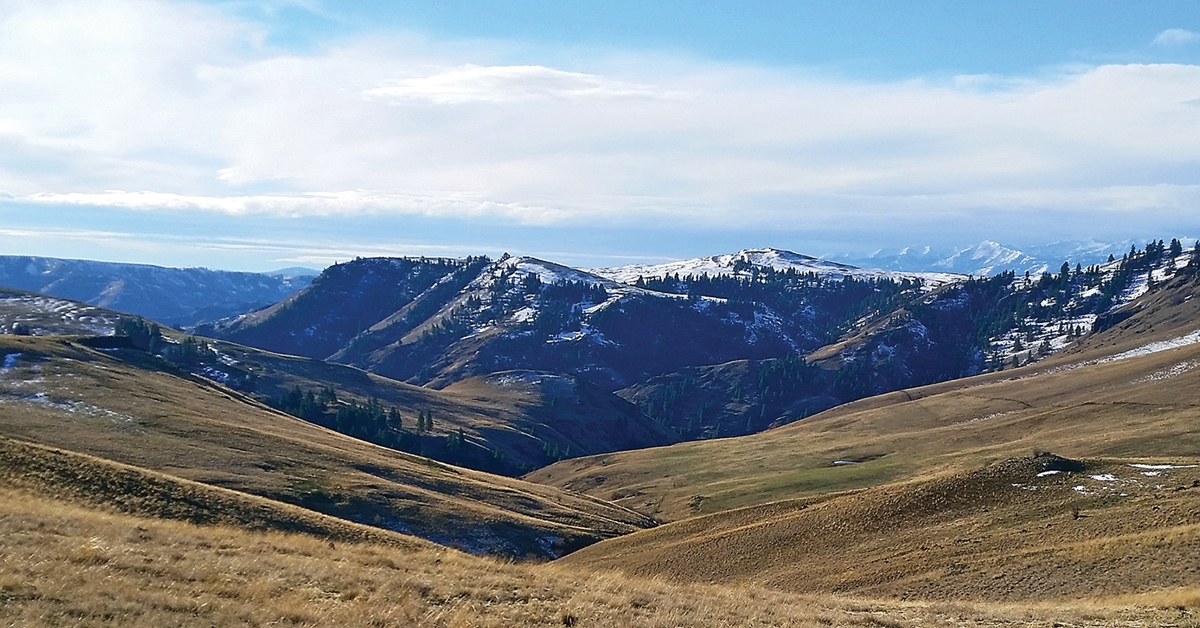Early morning sun was igniting the native grass pastures on the Zumwalt Prairie Preserve as our truck topped a rise and we saw sixty head of cow elk grazing peacefully like drops of caramel candy. The August landscape was a mix of golden pastures and green draws where the cows would go as the heat of the day made them look for shade. Elk are heat intolerant and the timbered draws of the Zumwalt Prairie Preserve are one reason, along with the lush bunchgrass, that the herds are so abundant. And this fall is the perfect time to hear bugling bull elk as they challenge each other for possession of cows.
Tucked away in northeast Oregon near Enterprise, the Preserve isn’t off a freeway. You don’t come here by accident. People come to the Preserve because of the rich wildlife, the immense landscape and the solitude. Almost twenty years ago, The Nature Conservancy purchased 33,000 acres of the larger 330,000 acre Zumwalt Prairie, the largest remaining grassland habitat of its type in North America. And few people know about it today.
But, one hundred fifty years ago, Chief Joseph and his band of Nez Perce sure knew about it: they traditionally hunted elk and deer here. This high plateau with rocky soil and short growing season never attracted farmers when white America moved West. Because of that, the native bunchgrass species were never plowed under, saving this unique ecosystem for future generations of wildlife. Cattle ranchers were the settlers here and ranching still is the economic driver.
The Nature Conservancy sees the Preserve as a living laboratory where they work with the latest science to integrate wildlife with cattle grazing by ranchers who have lived and worked on the prairie for generations. Keeping intact landscapes from development while maintaining healthy habitats for wildlife and cattle is the goal of this Preserve. Satellite imagery is being used to monitor grass health in pastures across the Preserve to ensure that cattle don’t graze too long in anyone place.
On any given day, the Preserve is home to the highest known population of breeding raptors in North America. These birds flourish because the intact grassland provides habitat for ground squirrels, a favorite food of raptors. The rodents feed Ferruginous and Swainson hawks, kestrels, prairie falcons, huge golden eagles floating high on thermals and rough-legged hawks migrating south in the fall. Stop your vehicle on any of the roads through the preserve and you won’t wait long to see numerous raptors in the clear sky. Be sure to bring along binoculars and a bird book because not only will you see raptors, but native songbirds as well as ground nesting birds like the Columbian sharp-tailed grouse and the horned lark live here. These ground nesting birds are one reason the Conservancy does not allow dogs in the Preserve.
No matter what time of year you visit, you’ll see plenty of elk. In the fall, bulls bugle to attract cows, to intimidate rivals and to announce that they are the “biggest and baddest” in the area.
This is typically the only time you will see mature bulls with cows. During the breeding season, which usually starts in early September and continues until sometime in October, you will see large antlered bulls jealously guarding their harems. The rest of the year you will see magnificent bulls in bachelor bands of four-ten at a time. On a recent August visit, we saw one large bull with a group of eight cows, but all the others we saw were in bachelor bands.
Taking the Canyon Vista Trail, a beautiful trail that ends in awesome views, we saw several enormous bulls sky-lighted on canyon rims. Because the Preserve controls hunting on the property, these monarchs of the ungulate world are common.
Mule deer are abundant on the Preserve as well. Notable for their large ears and their bounding run, called stotting, the males come into the rut in late October and early November and are easier to see then. The Nature Conservancy protects these deer and the bull elk by limiting the number of hunters allowed on the Preserve.
A small number of Land Owner Preference tags are issued to the Conservancy by Oregon Fish and Wildlife because of the habitat they provide for the elk and deer and the sheer numbers they have on the land. The Conservancy gives these tags to Wallowa County nonprofits to auction or raffle off. So far, over $300,000 has been raised for local charities through these tags.
Black bear, cougar, coyotes and badgers also call the Preserve home, so keep a sharp look out for these species as well.
The Nature Conservancy is busy working to restore riparian areas along creeks to enhance habitat for native fish and birds. Planting native species helps to improve the flow and function of the creeks. Visitors to the Preserve will also see exclosures. These are fenced areas where the Conservancy has planted quaking aspen.
The fences keep hungry cows, elk and deer from eating the trees, allowing them to grow to maturity.
A good way to sample the Preserve is to walk the four designated trails. The Horned Lark Trail is a 1.9 mile loop; Patti’s Trail is an easy 2.3 mile loop; the Harsin Butte Trail is a steeper climb of .8 miles but well worth the effort and finally the 1.8 mile Canyon Vista Trail is not to be missed for the sheer beauty of the scenery. No matter when you visit the Zumwalt Prairie Reserve, you’re sure to see abundant wildlife in a rare grassland landscape.
For more information go to www.nature.org and put in Zumwalt Prairie in the search box.
To get to the Preserve from Enterprise, take Hwy 82 towards Joseph for about 3 miles then turn left onto Crow Creek Rd. Continue about 5 miles then turn right on the Zumwalt/Buckhorn Road for approximately 13 miles. MSN










